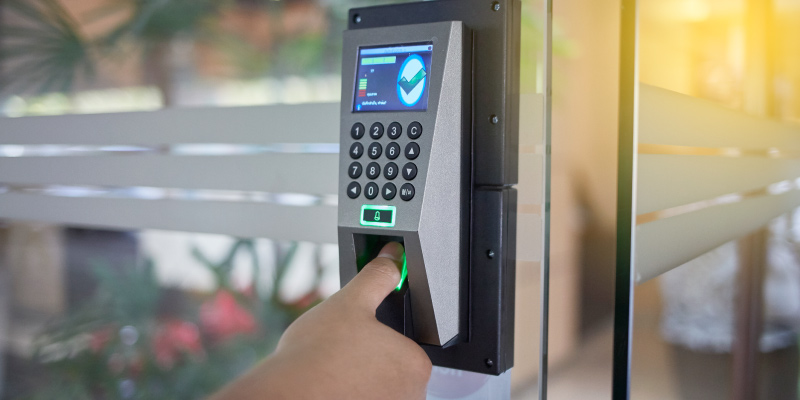In this blog post, we will explore strategies to help ensure the security of your business against potential threats. We will begin by examining the importance of establishing a clear understanding of your company's unique security needs and risks. Next, we'll discuss the benefits of implementing access control systems as well as providing comprehensive training for employees on essential security protocols. Subsequently, we'll concentrate on introducing strong cyber security measures to prevent malicious programs and phishing assaults.
Additionally, we will explore the development of an emergency plan tailored specifically for your business' network infrastructure. Lastly, don't forget about the significance of monitoring your premises regularly – ensuring both physical and virtual safety is paramount when it comes to keeping your small business safe from harm. By following these top security tips you should implement to protect your business, you'll be better equipped to face modern-day challenges head-on with confidence.
Establish security needs and risks
A recent study indicated that the vast majority of organizations experiencing substantial data loss are unable to remain in business for more than two years, while most entrepreneurs lack a strategy to secure their information. According to statisticbrain.com, about $50 billion is stolen from U.S. businesses by employees each year, with 75% of employees stealing more than once. Small and midsize companies are the hardest hit, with a median loss of $289,864 last year.
Employee theft isn't the only threat facing businesses. Burglary, cyberattacks, vandalism, and even employee turnover can make your business more vulnerable. To establish your security needs and risks:
Analyze online services
Identify the security risks for the online services and devices your company uses. Once these risks are identified, uncover ways to combat them or consider switching to new services if necessary.
Evaluate physical premises
Examine the structural security of your building (e.g., windows or doors) and any existing protective measures (e.g., locks or alarms).
Determine human factors
Consider how current policies regarding access control may be putting sensitive information at risk due to unauthorized personnel gaining entry into restricted areas.
Create a comprehensive plan
Develop a detailed strategy outlining specific actions needed to address identified threats while also prioritizing the most critical vulnerabilities. Once you've pinpointed your security needs and potential risks, it's essential to take action by putting safeguards in place that can help protect against any possible threats. Some examples include:
Invest in technology
Utilize advanced tools such as access control systems, alarm monitoring services, and surveillance cameras to enhance physical security at your premises.
Train employees
Ensure all staff members are aware of company policies regarding data protection and understand how to respond in case of a security incident or breach.
Maintain cyber hygiene
Regularly update software applications, deploy antivirus programs, encrypt sensitive information, limit access rights to vital data sources, and secure Wi-Fi networks for enhanced cybersecurity posture. Taking these steps can significantly reduce the likelihood of experiencing costly losses due to theft or other forms of attack on your business assets while also helping ensure long-term success in today's increasingly competitive marketplace.
Key thought:
To protect your business from potential threats, it's important to establish security needs and risks by analyzing online services/devices, evaluating physical premises, determining human factors and creating a comprehensive plan. Taking actions such as investing in technology, training employees on data protection policies and maintaining cyber hygiene can significantly reduce the likelihood of experiencing costly losses due to theft or other forms of attack on your business assets. Remember that 80% of business owners have no plan to protect their data so don't be one of them.
Establish access control systems
A robust access control system is essential for keeping your business premises secure. It helps prevent unauthorized individuals from entering the building and protects valuable assets, data, and employees. Here are some steps to establish an effective access control system:
- Invest in a reliable method of entry: Consider installing electronic locks or keycard systems on doors to limit unauthorized access.
- Purchase an alarm system: Choose a security provider like ADT or Vivint that offers 24/7 coverage and automatically notifies the police if an intruder attempts to gain entry.
- Install CCTV cameras: Strategically place surveillance cameras around your property to monitor activity and deter potential criminals.
- Select high-quality security doors and locking systems: Reinforce entrances with sturdy materials that resist forced entry attempts.
- Add lighting features: Illuminate dark areas with external lights to discourage trespassers while also ensuring employee safety during early morning or late-night hours.
- Create barriers for parking lots: Install parking barriers, bollards, and swinging gates to keep unwanted vehicles out of your premises' car park area.
- Limit key distribution: Only provide keys or access codes to essential personnel who require them for their job duties.
In addition, don't forget about securing valuables inside your business. Store cash, important records, and other valuable items in a fire-proof and securely anchored safe each night when closing the business.
By implementing these access control measures, you can significantly reduce the risk of unauthorized entry to your premises. Don't hesitate to explore different security providers like ADT and Vivint to find the perfect package for your needs. Remember that investing in robust security systems is crucial for protecting your assets, employees, and overall business operations.
Train employees on security protocols
To ensure optimal protection for your business, it is essential to equip staff with knowledge of security protocols. This not only helps prevent potential threats but also enables staff members to respond appropriately if a security incident occurs. Here are some key steps you can take to train your employees:
Create a comprehensive employee handbook
Construct a comprehensive guide that explains the organization's security regulations, practices, and protocols. This should include information about access control systems, cybersecurity measures, and emergency plans.
Conduct regular training sessions
Schedule periodic workshops or seminars for all staff members covering essential topics such as password management, email safety tips (e.g., avoiding phishing scams), and proper handling of sensitive data.
Incorporate role-specific training
Tailor additional training modules based on individual job responsibilities. For example, IT personnel may require more advanced instruction on network protection strategies while customer service representatives might need guidance on maintaining client privacy during phone calls.
Promote open communication channels
Encourage employees to report any suspicious activity or concerns they may have regarding workplace security without fear of retribution. Establishing an anonymous reporting system can be particularly helpful in this regard.
Beyond these basic steps, consider partnering with professional organizations like the National Cyber Security Alliance or local law enforcement agencies that offer resources and support for businesses looking to enhance their overall security posture. In addition to providing valuable insights into best practices for safeguarding both physical premises and digital assets from various threats (including thefts perpetrated by insiders), these partnerships can help foster a culture of security awareness throughout your organization.
By regularly keeping personnel apprised of potential risks and new developments, the probability of expensive violations or other occurrences that could damage your firm's standing or financials can be substantially reduced. Remember, employee training should be an ongoing process rather than a one-time event.
Regularly updating staff members on new threats and emerging trends is crucial for maintaining a strong defense against potential risks to your business.
Key thought:
To protect your business, train employees on security protocols by creating a comprehensive employee handbook, conducting regular training sessions and incorporating role-specific training. Promote open communication channels to encourage reporting of suspicious activity without fear of retribution. Partner with professional organizations for resources and support in enhancing overall security posture and maintain ongoing employee training to stay ahead of new threats.
Implement cybersecurity measures
Protecting your business from cyber threats and data breaches is crucial in today's digital world. Implementing strong cybersecurity measures can help safeguard sensitive information, maintain customer trust, and prevent financial losses. Here are some essential steps to follow:
Train your employees
Educate personnel on the value of cyber safety and how to detect probable dangers like fraudulent emails or dubious websites. Organize periodic seminars to stay informed on the newest security risks and procedures for avoiding them.
Carry out risk assessment
Analyze your company's current security posture by conducting a thorough risk assessment. This process will identify vulnerabilities within your systems and processes, allowing you to address them effectively.
Deploy antivirus software
Invest in reliable antivirus software, which provides real-time protection against malware, viruses, ransomware, and other online threats.
Keep software updated
Maintain regular updates for all devices and applications used within your organization. Software patches often include important security fixes that protect against known vulnerabilities.
Back up your files regularly
Create a routine schedule for backing up critical data both onsite (e.g., external hard drives) and offsite (e.g., cloud storage). In case of a system failure or cyberattack, having multiple backups ensures quick recovery with minimal disruption to operations.
Encrypt key information
Encrypt sensitive data, including customer records, financial information, and employee details. Encryption makes it harder for unapproved individuals to access or decode the data. Implement strict user permissions and role-based access controls (RBAC) to ensure that only authorized personnel can view or modify confidential information. Protect your company's wireless network by using strong encryption protocols like WPA2, changing default passwords on routers, and disabling remote management features. Additionally, consider setting up a separate guest network for visitors' use.
To ensure your company's security, implementing a comprehensive cybersecurity plan with the aforementioned measures is essential. Stay vigilant in monitoring new developments in cybercrime trends so you can adapt accordingly and maintain a secure digital environment for your organization.
Key thought:
To protect your business from cyber threats and data breaches, it is crucial to implement strong cybersecurity measures such as training employees on potential risks, conducting risk assessments, investing in reliable antivirus software, regularly updating software and backing up critical data. Encrypting sensitive information and implementing strict user permissions can also help safeguard against unauthorized access. Stay vigilant in monitoring new developments in cybercrime trends to maintain a secure digital environment for your organization.
Develop an emergency plan
Don't postpone devising a strategy to handle crises until one occurs. Consequently, it is essential to create a plan that enables swift and effective action in the event of any potential risks. Here are some steps to get started:
Identify potential risks
First things first, identify the specific risks that your business may face. Think about potential threats such as natural disasters, cyberattacks, location-specific risks and any prior occurrences your business has encountered. Consider your location, industry-specific hazards, and any past incidents you've experienced.
Create response procedures
Once you've identified potential risks, develop clear response procedures for each scenario. Make sure your employees know what to do in case of an emergency. For example, in case of a fire, establish evacuation routes and meeting points outside the building. In case of a cyberattack, isolate affected systems and notify IT support immediately. And in case of a break-in, safely lock down premises and contact law enforcement agencies. For a comprehensive emergency response plan tailored specifically for your organization, follow FEMA's Emergency Response Plan Guide.
Assign roles and responsibilities
Determine which team members will be responsible for executing different aspects of your emergency plan. Assigning specific roles ensures that everyone knows what they're supposed to do during an incident - this can help prevent confusion when time is critical.
Maintain communication channels with stakeholders
Establish a communication plan to keep employees, customers, and other stakeholders informed during an emergency. This can include setting up a phone tree or mass notification system, as well as designating spokespeople who will liaise with the media.
Conduct regular drills and reviews
Practice makes perfect. Regularly practice your emergency response procedures through drills and simulations. This helps ensure that everyone is familiar with their roles and responsibilities in case of an actual incident. Additionally, review your plan periodically to make any necessary updates based on new risks or changes within your business. By taking these steps, you can help protect both your employees' safety and the continuity of your business operations during unexpected events. Don't wait until it's too late - start developing your emergency plan today.
Key thought:
Developing an emergency plan is crucial for any business to respond quickly and effectively to potential threats. To get started, identify potential risks, create response procedures, assign roles and responsibilities, establish communication channels with stakeholders, conduct regular drills and reviews. By taking these steps you can protect your employees' safety and ensure the continuity of your business operations during unexpected events.
Regularly monitor your business premises for maximum security
Don't let security breaches catch you off guard. Keep your business premises safe by conducting regular checks and implementing effective strategies. Here are some tips to get you started:
Create a schedule for routine inspections
Inspect your property regularly to identify vulnerabilities and areas that need improvement. Check locks, doors, windows, lighting systems, alarm systems, and CCTV cameras. Keep everything in good working order to prevent security breaches.
Utilize technology solutions
Modern technology can enhance your business's overall security. Consider investing in smart cameras with motion detection capabilities or cloud-based access control systems. These cutting-edge solutions can enable you to watch over your premises remotely, even in the absence of a physical presence.
Maintain clear communication with employees
Your staff plays a crucial role in keeping your business safe. Encourage open communication about any observed irregularities or concerns related to safety within the workplace. Address issues promptly to prevent them from escalating.
Hire professional security services if necessary
If you need additional support for securing your property effectively, consider hiring professional security services like ADT or Vivint. These companies offer a range of solutions tailored to your specific needs, such as 24/7 monitoring and emergency response services. To keep your business safe, it is essential to continually assess and modify security measures as needed. Remember that regular monitoring is an ongoing process, so stay vigilant and make adjustments as needed to ensure the safety of your property and employees.
FAQs
Essential security measures for your business
Access control systems, surveillance cameras, alarm systems, cybersecurity practices, employee training, and emergency plans are crucial for business security.
Top 3 security concerns for small business networks
Weak passwords, unsecured Wi-Fi networks, and ransomware attacks are the top concerns for small businesses, so strong network security is a must.
Implementing effective business security
Assess risks, install physical barriers, set up cyber defenses, train employees, develop an emergency response plan, and regularly monitor the premises.
Top 3 network security measures for companies
Companies need to implement firewalls, encryption, and regular security updates to ensure network security.
Conclusion
Businesses face numerous security risks that can lead to significant financial and reputational damage, but you can safeguard your business by implementing these top security tips:
- Assess your security needs and risks to identify potential vulnerabilities.
- Establish access control systems to limit who can access sensitive areas or information.
- Train employees on security protocols to ensure everyone is on the same page.
- Implement cyber-security measures to protect against online threats.
- Develop an emergency plan to respond quickly in case of a security breach.
- Regularly monitor your premises to detect any suspicious activity.
By taking a proactive approach to securing all aspects of your operations, you can minimize the risk of breaches or attacks and keep sensitive data safe from harm.











